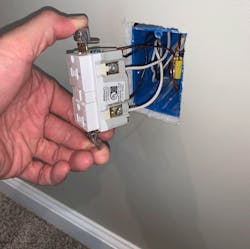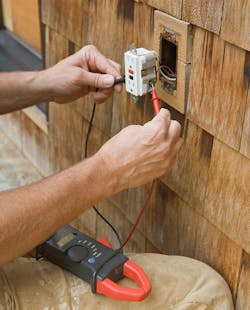Recent Rule Changes for GFCI Protection
During the recent 2020 Code review process, panel members of the National Electrical Code (NEC) approved changes to ground fault circuit interrupter (GFCI) protection. The changes are meant to reduce the dangers associated with electrical hazard and shock. The most significant change is the increase of amp protection ratings across all receptacle outlets (both indoor and outdoor) wherever GFCI protection is required.
Some of these updates apply to long-standing Code requirements. As such, there may be a need for additional clarification down the road. For now, let’s look at how some of these changes will impact the work electrical professionals currently perform for their customers.
GFCI language expansion
The 2020 change: Code-making panel 2 (CMP 2) updated the text to read, “All 125V through 250V receptacles installed in the locations specified in 210.8(A) (1) through (11) and supplied by single-phase branch circuits rated 150V or less to ground shall have ground fault circuit interrupter protection for personnel.”
In layman’s terms, the NEC removed amp values across all amp-rated receptacle outlets requiring GFCI protection in the areas listed in this section.
The rationale for change: NEC 2017 language only accounts for 15A and 20A receptacle outlets for dwelling units. During 2020 Code review meetings, panel members agreed that hazards always exist; if 15A and 20A receptacle outlets present a hazard, that hazard also exists on 30A and higher receptacle outlets. However, it was difficult to understand the likelihood of a hazardous occurrence when weighed against expanded requirements.
Recent home-based electrocution accidents — a 10-year-old girl behind an energized appliance, a child in Oklahoma retrieving a pet behind a clothes dryer, and a 10-year-old Houston boy playing hide and seek — helped panel members realize the need for change. Considering these tragic events, we now have a requirement that sets a higher standard across more areas of the Code (although there are some exceptions noted later in this article).
What might the future hold? The NEC mandates GFCI protection in many areas of the home: bathrooms, garages, outdoor receptacles, crawl spaces, basements, kitchens, and anything within 6 feet of a sink or water source. While that may seem like a lot, the entirety of a home is not covered. The reality is when people have a problem with a tripped circuit, it’s entirely possible they’ll use an extension cord to plug into a receptacle outlet that’s not GFCI protected. Doing so does nothing to eliminate the original hazard potentially caused by the device in use. This will most likely be a discussion point during this next Code review process.
Better protection in basements
The 2020 change: The NEC expanded GFCI protection for dwelling units with basements both finished and unfinished.
The rationale for change: Often seen as afterthoughts that present unique hazards, basements are typically not as well maintained as other areas of the home. Further, these environments are often wet and damp — and moisture is a great conductor of electricity. Recent Code updates help ensure that accidents due to factors such as leakage current and contact with water are considerably lessened or eliminated.
What might the future hold? As noted earlier, many rooms in a home are already required to have GFCI protection. While it feels like the most logical Code progression is to expand these requirements even further, some in the industry still pushback on requiring GFCIs throughout a home, claiming financial concerns or installation problems. You can bet these discussions will continue in this new Code cycle.
Safer equipment maintenance for workers
The 2020 change: The NEC expanded GFCI protection under Sec. 210.63(A) for HVAC equipment and Sec. 210.63(B) for indoor service equipment and indoor equipment requiring dedicated space.
The rationale for change: Equipment location is at the crux of this update. While HVAC equipment in the basement is covered now that all basement circuits are required to be GFCI protected, HVAC equipment located in attics and other areas would likely not have GFCI protection. CMP 2 recognized that many HVAC areas are typically tight working spaces where technicians perform justified energized work (they can’t troubleshoot a de-energized circuit). The update assures equipment requiring service has a GFCI-protected receptacle outlet for ready access.
What might the future hold? Since this is the NEC’s first venture into expanding Sec. 210.63, we can expect some inspectors and contractors may not see eye-to-eye on the Code language. Industry discussions across the country and during future review cycles will likely help the NEC make future improvements.
Safer outdoor outlets
The 2020 change: The NEC updated the requirements for outdoor outlets supplied by single-phase branch circuits rated 150V to ground or less, 50A or less. Key to this update is it extends beyond receptacle outlets to include all outlets. Now, all hard-wired equipment falls under the Code’s purview.
The rationale for change: Accidents are often the catalyst for change when it comes to NEC requirements. Numerous incidents inspired this Code change, including an accident involving a 12-year-old boy who jumped over a fence and touched an AC condenser unit with an electrical fault. The outer metal housing was electrified, and the child was electrocuted immediately upon contacting the condenser and fence simultaneously.
What might the future hold? GFCI technology is unforgiving in that it’s built to detect even the slightest power variance. When expanded to include outlets impacting new types of loads, questions arise. With GFCIs installed, leakage-current trips may be near constant, rendering large equipment unusable. This Code change might get industries to offer products with acceptable leakage current, hertz, and frequency values, which would reduce future compatibility issues.
Further, this change will likely spur discussions related to existing GFCI requirements focused only on receptacle outlets. Hardwiring equipment does not eliminate the electrical hazard. There’s a good chance someone will propose public inputs during this new Code cycle to challenge details about receptacle outlets versus outlets requiring GFCI protection.
Sweeping global language changes
The 2020 change: The NEC reviewed all locations with a GFCI requirement and aligned everything with Sec. 210.8. Updates were made in many locations to include text such as “in addition to the requirements of 210.8” or similar, to clarify language and eliminate misinterpretation.
The rationale for change: Section 210.8(B) [Other Than Dwellings] was added to the Code in 1993. Before its inclusion, builders relied on requirements in later chapters of the Code (chapters five through seven) for safety guidance. For example, when RV park GFCI requirements were added to the 1978 NEC, they aligned with 15A and 20A receptacle outlet GFCI protection philosophy at that time.
When Sec. 210.8(B) increased GFCI protection requirements beyond 15A and 20A receptacle outlets for other than dwelling units in the 2017 edition of the NEC, this created some confusion. It also presented a challenge because a Chapter Two requirement now applied a generally wider level of GFCI protection. This conflicted with Chapter Five, which has less coverage of GFCI protection.
The NEC Correlating Committee recognized similar conflicts existed across industries and formulated a task group to address this issue. The task group challenged every Code panel to look at their GFCI requirements and attempt to align them with the 50A increase in Sec. 210.8. Each CMP performed their review; some made changes, while others did not.
What might the future hold? There is room for discussion in future revisions of the Code regarding shock hazards in special areas other than dwelling unit applications. Why? Because each application in Chapters Five through Seven approaches GFCI protection differently.
The NEC continues to make great strides in safety
Extending the amp requirement across all receptacles is a milestone that cannot be understated — it will change how industries work. Many of the changes discussed above represent the first step toward increasing safety in these additional areas. Industry feedback on these new requirements will be critically important throughout the 2023 Code cycle.
Domitrovich is vice president, technical sales for Eaton. He can be reached at [email protected].
About the Author
Thomas Domitrovich
National Application Engineer
Domitrovich is an Electrical Engineer within Eaton’s electrical group with experience in engineering, sales & marketing, business development and product management. He is actively involved with various electrical industry organizations and most recently focuses on the continued growth of electrical safety. Domitrovich is an author with a wide range of trade magazine articles including columns in two industry trade magazines focused on electrical safety. He sits on NFPA Code Making Panel 2 for the continued development of the National Electrical Code (NFPA 70). He is also on the NFPA committee for the continued development of NFPA 73 and chairs various committees for other electrical industry organizations. Domitrovich is a LEED Accredited Professional, a licensed Professional Engineer and holds a Bachelor of Electrical Engineering from Gannon University.



